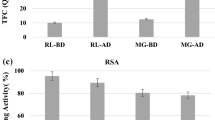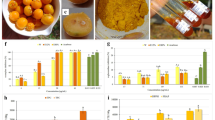Abstract
In this study, in vitro digestion of polyphenols of oleaster (Elaeagnus angustifolia L.) flour (OF) and the potential use of OF in cracker production were studied. The results showed that 21.90 mg gallic acid equivalent (GAE)/g dry matter (DM) of total polyphenol (TP), 28.15 mg rutin equivalent (RE)/g DM of total flavonoid (TF) and 7709.13 mmol ascorbic acid equivalent (AAE)/100 g DM of antioxidant capacity (AC) were found in OF. The bioaccessibility and content of the OF polyphenols and their AC during in vitro digestion varied depending on the digestion stage. The stability of the OF polyphenols was higher in gastric stage (41.92%) than intestinal one (34.01%). OF was used to replace flour in the cracker formulation at the levels of 5, 10 and 15% (w/w) and increased the TP contents and AC of the crackers compared to the sample without OF (control). The addition of OF to the cracker dough increased the bioaccessibility of the cracker polyphenols. After digestion, bioaccessibilities of enriched crackers (107.90-126.81%) were found higher than that of control sample (93.73%). However, as the level of OF in cracker increased, bioaccessibility of polyphenols decreased. The results generally indicated that oleaster has a good potential for the enrichment of foods.
Similar content being viewed by others
Data Availability
Not applicable.
References
Dilek Tepe H, Doyuk F (2020) Determination of phytochemical content by chromatographic methods and antioxidant capacity in methanolic extract of jujube (Zizyphus jujuba mill.) and oleaster (Elaeagnus angustifolia L.). Int J Fruit Sci 20:S1876–S1890. https://doi.org/10.1080/15538362.2020.1834900
Cansev A, Sahan Y, Celik G et al (2011) Chemical properties and antioxidant capacity of Elaeagnus angustifolia L. fruits. Asian J Chem 23:2661–2665
Simsek M, Sufer Ö (2021) Physical, bioactive and textural properties of oleaster (Elaeagnus angustifolia L.) fruit from different locations in Turkey. Turkish J Agric - food Sci Technol 9:723–727. https://doi.org/10.24925/turjaf.v9i4.723-727.4025
Hassanzadeh Z, Hassanpour H (2018) Evaluation of physicochemical characteristics and antioxidant properties of Elaeagnus angustifolia L. Sci Hortic (Amsterdam) 238:83–90. https://doi.org/10.1016/j.scienta.2018.04.041
Sanz-Puig M, Moreno P, Pina-Pérez MC et al (2017) Combined effect of high hydrostatic pressure (HHP) and antimicrobial from agro-industrial by-products against S. typhimurium. LWT-Food Sci Technol 77:126–133. https://doi.org/10.1016/j.lwt.2016.11.031
Ismail BB, Guo M, Pu Y et al (2021) Investigating the effect of in vitro gastrointestinal digestion on the stability, bioaccessibility, and biological activities of baobab (Adansonia digitata) fruit polyphenolics. LWT-Food Sci Technol 145. https://doi.org/10.1016/j.lwt.2021.111348
Sahan Y, Aydin E, Dundar AI et al (2019) Effects of oleaster flour supplementation in total phenolic contents, antioxidant capacities and their bioaccessibilities of cookies. Food Sci Biotechnol 28:1401–1408. https://doi.org/10.1007/s10068-019-00589-6
Öztürk Hİ, Aydın S, Sözeri D et al (2018) Fortification of set-type yoghurts with Elaeagnus angustifolia L. flours: effects on physicochemical, textural, and microstructural characteristics. LWT-Food Sci Technol 90:620–626. https://doi.org/10.1016/j.lwt.2018.01.012
Çakmakçi S, Topdaş EF, Kalin P et al (2015) Antioxidant capacity and functionality of oleaster (Elaeagnus angustifolia L.) flour and crust in a new kind of fruity ice cream. Int J Food Sci Technol 50:472–481. https://doi.org/10.1111/ijfs.12637
Sarvarian M, Jafarpour A, Awuchi CG et al (2022) Changes in physicochemical, free radical activity, total phenolic and sensory properties of orange (Citrus sinensis L.) juice fortified with different oleaster (Elaeagnus angustifolia L.) extracts. Molecules 27:1–17. https://doi.org/10.3390/molecules27051530
Wang S, Amigo-Benavent M, Mateos R et al (2017) Effects of in vitro digestion and storage on the phenolic content and antioxidant capacity of a red grape pomace. Int J Food Sci Nutr 68:188–200. https://doi.org/10.1080/09637486.2016.1228099
Rodrigues DB, Marques MC, Hacke A et al (2022) Trust your gut: bioavailability and bioaccessibility of dietary compounds. Curr Res Food Sci 5:228–233. https://doi.org/10.1016/j.crfs.2022.01.002
Gullon B, Pintado ME, Fernández-López J et al (2015) In vitro gastrointestinal digestion of pomegranate peel (Punica granatum) flour obtained from co-products: changes in the antioxidant potential and bioactive compounds stability. J Funct Foods 19:617–628. https://doi.org/10.1016/j.jff.2015.09.056
Gìltekin-Özgìven M, Berktaş I, Özçelik B (2016) Change in stability of procyanidins, antioxidant capacity and in-vitro bioaccessibility during processing of cocoa powder from cocoa beans. LWT - Food Sci Technol 72:559–565. https://doi.org/10.1016/j.lwt.2016.04.065
Bouayed J, Deußer H, Hoffmann L, Bohn T (2012) Bioaccessible and dialysable polyphenols in selected apple varieties following in vitro digestion vs. their native patterns. Food Chem 131:1466–1472. https://doi.org/10.1016/j.foodchem.2011.10.030
Polat H, Dursun Capar T, Inanir C et al (2020) Formulation of functional crackers enriched with germinated lentil extract: a response surface methodology box-Behnken design. LWT-Food Sci Technol 123:109065. https://doi.org/10.1016/j.lwt.2020.109065
ISO 14502-1:2005 Determination of substances characteristic of green and black tea. Part 1: Content of total polyphenols in tea. Colorimetric method using Folin-Ciocalteu reagent. 8p
Rodrigues MJ, Neves V, Martins A et al (2016) In vitro antioxidant and anti-inflammatory properties of Limonium algarvense flowers’ infusions and decoctions: a comparison with green tea (Camellia sinensis). Food Chem 200:322–329. https://doi.org/10.1016/j.foodchem.2016.01.048
Türkmen Erol N, Sari F, Çalikoǧlu E, Velioǧlu YS (2009) Green and roasted mate: phenolic profile and antioxidant activity. Turkish J Agric For 33:353–362. https://doi.org/10.3906/tar-0901-4
Minekus M, Alminger M, Alvito P et al (2014) A standardised static in vitro digestion method suitable for food-an international consensus. Food Funct 5:1113–1124. https://doi.org/10.1039/c3fo60702j
Incedayi B, Dogan N, Copur OU (2022) Assessment of cactus pear leather (pestil) as a new snack food. J Food Sci Technol 59:3158–3166. https://doi.org/10.1007/s13197-022-05366-8
Karkar B, Şahin S (2022) Determination of phenolic compounds profiles and antioxidant properties of oleaster (Elaeagnus angustifolia L.) grown in Turkey. Eur Food Res Technol 248:219–241. https://doi.org/10.1007/s00217-021-03875-y
Fawole OA, Opara UL (2016) Stability of total phenolic concentration and antioxidant capacity of extracts from pomegranate co-products subjected to in vitro digestion. BMC Complement Altern Med 16:1–10. https://doi.org/10.1186/s12906-016-1343-2
Figueroa F, Marhuenda J, Zafrilla P et al (2016) Total phenolics content, bioavailability and antioxidant capacity of 10 different genotypes of walnut (Juglans regia L.). J Food Nutr Res 55:229–236
He Z, Tao Y, Zeng M et al (2016) High pressure homogenization processing, thermal treatment and milk matrix affect in vitro bioaccessibility of phenolics in apple, grape and orange juice to different extents. Food Chem 200:107–116. https://doi.org/10.1016/j.foodchem.2016.01.045
Ma Y, Zhou M, Huang H (2014) Changes of heat-treated soymilks in bioactive compounds and their antioxidant activities under in vitro gastrointestinal digestion. Eur Food Res Technol 239:637–652. https://doi.org/10.1007/s00217-014-2260-6
Tu F, Xie C, Li H et al (2021) Effect of in vitro digestion on chestnut outer-skin and inner-skin bioaccessibility: the relationship between biotransformation and antioxidant activity of polyphenols by metabolomics. Food Chem 363:130277. https://doi.org/10.1016/j.foodchem.2021.130277
Chen GL, Hu K, Zhong NJ et al (2013) Antioxidant capacities and total polyphenol content of nine commercially available tea juices measured by an in vitro digestion model. Eur Food Res Technol 236:303–310. https://doi.org/10.1007/s00217-012-1897-2
Pinto J, Spínola V, Llorent-Martínez EJ et al (2017) Polyphenolic profile and antioxidant activities of Madeiran elderberry (Sambucus lanceolata) as affected by simulated in vitro digestion. Food Res Int 100:404–410. https://doi.org/10.1016/j.foodres.2017.03.044
Xiong J, Chan YH, Rathinasabapathy T et al (2020) Enhanced stability of berry pomace polyphenols delivered in protein-polyphenol aggregate particles to an in vitro gastrointestinal digestion model. Food Chem 331:127279. https://doi.org/10.1016/j.foodchem.2020.127279
Bouayed J, Hoffmann L, Bohn T (2011) Total phenolics, flavonoids, anthocyanins and antioxidant activity following simulated gastro-intestinal digestion and dialysis of apple varieties: bioaccessibility and potential uptake. Food Chem 128:14–21. https://doi.org/10.1016/j.foodchem.2011.02.052
Nezamdoost-Sani N, Asghari-Jafarabadi M, Mohtadinia J (2018) Influence of Elaeagnus angustifolia flour on the organoleptic and physicochemical characteristics of bread (LAVASH). Prog Nutr 20:84–89. https://doi.org/10.23751/pn.v20i1-S.5835
Sarraf M, Sani AM, Atash MMS (2017) Physicochemical, organoleptic characteristics and ımage analysis of the doughnut enriched with oleaster flour. J Food Process Preserv 41:1–9. https://doi.org/10.1111/jfpp.13021
Author information
Authors and Affiliations
Contributions
Bige Incedayi: Methodology, Formal analysis and investigation, Review and editing, Resources.
Nihal Turkmen Erol: Conceptualization, Formal analysis and investigation, Writing – original draft preparation, Supervision.
Corresponding author
Ethics declarations
Ethics Approval
Not applicable.
Consent to Participate
Not applicable.
Consent for Publication
Not applicable.
Conflict of Interest
Both authors declare that they have no conflict of interest.
Additional information
Publisher’s Note
Springer Nature remains neutral with regard to jurisdictional claims in published maps and institutional affiliations.
Rights and permissions
Springer Nature or its licensor (e.g. a society or other partner) holds exclusive rights to this article under a publishing agreement with the author(s) or other rightsholder(s); author self-archiving of the accepted manuscript version of this article is solely governed by the terms of such publishing agreement and applicable law.
About this article
Cite this article
Incedayi, B., Erol, N.T. Assessment of the Bioaccessibility of Elaeagnus angustifolia L. Flour and Its Use in Cracker Formulation. Plant Foods Hum Nutr 78, 201–206 (2023). https://doi.org/10.1007/s11130-022-01041-7
Accepted:
Published:
Issue Date:
DOI: https://doi.org/10.1007/s11130-022-01041-7




